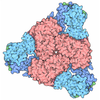+ Open data
Open data
- Basic information
Basic information
| Entry | Database: PDB / ID: 2rk3 | ||||||
|---|---|---|---|---|---|---|---|
| Title | Structure of A104T DJ-1 | ||||||
 Components Components | Protein DJ-1 | ||||||
 Keywords Keywords | CHAPERONE / PARKINSON'S DISEASE / THIJ / PFPI / Cytoplasm / Disease mutation / Nucleus / Oncogene / Oxidation / Parkinson disease / Phosphorylation / Polymorphism / Ubl conjugation | ||||||
| Function / homology |  Function and homology information Function and homology informationpositive regulation of acute inflammatory response to antigenic stimulus / tyrosine 3-monooxygenase activator activity / cellular response to glyoxal / L-dopa decarboxylase activator activity / detoxification of hydrogen peroxide / methylglyoxal catabolic process to lactate / guanine deglycation, methylglyoxal removal / guanine deglycation, glyoxal removal / cellular detoxification of methylglyoxal / regulation of supramolecular fiber organization ...positive regulation of acute inflammatory response to antigenic stimulus / tyrosine 3-monooxygenase activator activity / cellular response to glyoxal / L-dopa decarboxylase activator activity / detoxification of hydrogen peroxide / methylglyoxal catabolic process to lactate / guanine deglycation, methylglyoxal removal / guanine deglycation, glyoxal removal / cellular detoxification of methylglyoxal / regulation of supramolecular fiber organization / negative regulation of death-inducing signaling complex assembly / negative regulation of TRAIL-activated apoptotic signaling pathway / positive regulation of L-dopa biosynthetic process / glyoxalase (glycolic acid-forming) activity / negative regulation of protein K48-linked deubiquitination / negative regulation of nitrosative stress-induced intrinsic apoptotic signaling pathway / glycolate biosynthetic process / detection of oxidative stress / glyoxal metabolic process / guanine deglycation / methylglyoxal metabolic process / detoxification of mercury ion / ubiquitin-protein transferase inhibitor activity / protein deglycase / mercury ion binding / hydrogen peroxide metabolic process / positive regulation of dopamine biosynthetic process / protein deglycase activity / positive regulation of autophagy of mitochondrion / superoxide dismutase copper chaperone activity / oxidoreductase activity, acting on peroxide as acceptor / positive regulation of mitochondrial electron transport, NADH to ubiquinone / lactate biosynthetic process / negative regulation of hydrogen peroxide-induced neuron intrinsic apoptotic signaling pathway / protein repair / peptidase inhibitor activity / cellular detoxification of aldehyde / peroxiredoxin activity / Hydrolases; Acting on ester bonds; Thioester hydrolases / small protein activating enzyme binding / regulation of oxidative stress-induced neuron intrinsic apoptotic signaling pathway / detoxification of copper ion / negative regulation of protein sumoylation / positive regulation of oxidative stress-induced intrinsic apoptotic signaling pathway / negative regulation of protein export from nucleus / cupric ion binding / negative regulation of oxidative stress-induced neuron intrinsic apoptotic signaling pathway / regulation of androgen receptor signaling pathway / membrane hyperpolarization / oxygen sensor activity / Hydrolases; Acting on carbon-nitrogen bonds, other than peptide bonds; In linear amides / negative regulation of intrinsic apoptotic signaling pathway in response to hydrogen peroxide / insulin secretion / ubiquitin-like protein conjugating enzyme binding / nuclear androgen receptor binding / androgen receptor signaling pathway / ubiquitin-specific protease binding / cytokine binding / dopamine uptake involved in synaptic transmission / positive regulation of reactive oxygen species biosynthetic process / cuprous ion binding / signaling receptor activator activity / membrane depolarization / regulation of synaptic vesicle endocytosis / single fertilization / negative regulation of endoplasmic reticulum stress-induced intrinsic apoptotic signaling pathway / negative regulation of oxidative stress-induced intrinsic apoptotic signaling pathway / regulation of neuron apoptotic process / negative regulation of reactive oxygen species biosynthetic process / negative regulation of proteasomal ubiquitin-dependent protein catabolic process / negative regulation of protein ubiquitination / removal of superoxide radicals / SUMOylation of transcription cofactors / adult locomotory behavior / regulation of mitochondrial membrane potential / positive regulation of interleukin-8 production / negative regulation of extrinsic apoptotic signaling pathway / mitochondrion organization / adherens junction / positive regulation of protein-containing complex assembly / enzyme activator activity / Late endosomal microautophagy / PML body / mitochondrial intermembrane space / autophagy / positive regulation of protein localization to nucleus / kinase binding / cellular response to hydrogen peroxide / Chaperone Mediated Autophagy / positive regulation of reactive oxygen species metabolic process / Aggrephagy / synaptic vesicle / glucose homeostasis / peptidase activity / cell body / regulation of inflammatory response / cellular response to oxidative stress / response to oxidative stress / scaffold protein binding / DNA-binding transcription factor binding Similarity search - Function | ||||||
| Biological species |  Homo sapiens (human) Homo sapiens (human) | ||||||
| Method |  X-RAY DIFFRACTION / X-RAY DIFFRACTION /  SYNCHROTRON / SYNCHROTRON /  MOLECULAR REPLACEMENT / Resolution: 1.05 Å MOLECULAR REPLACEMENT / Resolution: 1.05 Å | ||||||
 Authors Authors | Lakshminarasimhan, M. / Maldonado, M.T. / Zhou, W. / Fink, A.L. / Wilson, M.A. | ||||||
 Citation Citation |  Journal: Biochemistry / Year: 2008 Journal: Biochemistry / Year: 2008Title: Structural Impact of Three Parkinsonism-Associated Missense Mutations on Human DJ-1. Authors: Lakshminarasimhan, M. / Maldonado, M.T. / Zhou, W. / Fink, A.L. / Wilson, M.A. | ||||||
| History |
|
- Structure visualization
Structure visualization
| Structure viewer | Molecule:  Molmil Molmil Jmol/JSmol Jmol/JSmol |
|---|
- Downloads & links
Downloads & links
- Download
Download
| PDBx/mmCIF format |  2rk3.cif.gz 2rk3.cif.gz | 94.9 KB | Display |  PDBx/mmCIF format PDBx/mmCIF format |
|---|---|---|---|---|
| PDB format |  pdb2rk3.ent.gz pdb2rk3.ent.gz | 71.7 KB | Display |  PDB format PDB format |
| PDBx/mmJSON format |  2rk3.json.gz 2rk3.json.gz | Tree view |  PDBx/mmJSON format PDBx/mmJSON format | |
| Others |  Other downloads Other downloads |
-Validation report
| Summary document |  2rk3_validation.pdf.gz 2rk3_validation.pdf.gz | 425.8 KB | Display |  wwPDB validaton report wwPDB validaton report |
|---|---|---|---|---|
| Full document |  2rk3_full_validation.pdf.gz 2rk3_full_validation.pdf.gz | 426.4 KB | Display | |
| Data in XML |  2rk3_validation.xml.gz 2rk3_validation.xml.gz | 11.2 KB | Display | |
| Data in CIF |  2rk3_validation.cif.gz 2rk3_validation.cif.gz | 16.7 KB | Display | |
| Arichive directory |  https://data.pdbj.org/pub/pdb/validation_reports/rk/2rk3 https://data.pdbj.org/pub/pdb/validation_reports/rk/2rk3 ftp://data.pdbj.org/pub/pdb/validation_reports/rk/2rk3 ftp://data.pdbj.org/pub/pdb/validation_reports/rk/2rk3 | HTTPS FTP |
-Related structure data
| Related structure data |  2rk4C  2rk6C  3b36C 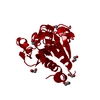 3b38C 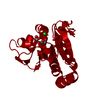 3b3aC  1p5fS C: citing same article ( S: Starting model for refinement |
|---|---|
| Similar structure data |
- Links
Links
- Assembly
Assembly
| Deposited unit | 
| ||||||||
|---|---|---|---|---|---|---|---|---|---|
| 1 | 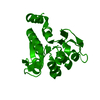
| ||||||||
| Unit cell |
| ||||||||
| Components on special symmetry positions |
|
- Components
Components
| #1: Protein | Mass: 21018.232 Da / Num. of mol.: 1 / Mutation: A104T Source method: isolated from a genetically manipulated source Source: (gene. exp.)  Homo sapiens (human) / Gene: PARK7 / Plasmid: pET15b / Species (production host): Escherichia coli / Production host: Homo sapiens (human) / Gene: PARK7 / Plasmid: pET15b / Species (production host): Escherichia coli / Production host:  |
|---|---|
| #2: Water | ChemComp-HOH / |
-Experimental details
-Experiment
| Experiment | Method:  X-RAY DIFFRACTION / Number of used crystals: 1 X-RAY DIFFRACTION / Number of used crystals: 1 |
|---|
- Sample preparation
Sample preparation
| Crystal | Density Matthews: 3.03 Å3/Da / Density % sol: 59.46 % |
|---|---|
| Crystal grow | Temperature: 298 K / Method: vapor diffusion, hanging drop / pH: 7.5 Details: 30% PEG 3000, 100 mM HEPES, 200 mM NaCl, pH 7.5, VAPOR DIFFUSION, HANGING DROP, temperature 298K |
-Data collection
| Diffraction | Mean temperature: 110 K |
|---|---|
| Diffraction source | Source:  SYNCHROTRON / Site: SYNCHROTRON / Site:  SSRL SSRL  / Beamline: BL11-1 / Wavelength: 0.98 Å / Beamline: BL11-1 / Wavelength: 0.98 Å |
| Detector | Type: ADSC QUANTUM 315 / Detector: CCD / Date: Apr 25, 2005 |
| Radiation | Monochromator: Single Crystal Bent Si(111) / Protocol: SINGLE WAVELENGTH / Monochromatic (M) / Laue (L): M / Scattering type: x-ray |
| Radiation wavelength | Wavelength: 0.98 Å / Relative weight: 1 |
| Reflection | Resolution: 1.05→50 Å / Num. all: 110339 / Num. obs: 110339 / % possible obs: 97.8 % / Redundancy: 5.7 % / Rmerge(I) obs: 0.043 / Net I/σ(I): 33.9 |
| Reflection shell | Resolution: 1.05→1.09 Å / Redundancy: 3.8 % / Rmerge(I) obs: 0.437 / Mean I/σ(I) obs: 2.6 / Num. unique all: 10567 / % possible all: 94.5 |
- Processing
Processing
| Software |
| |||||||||||||||||||||||||||||||||
|---|---|---|---|---|---|---|---|---|---|---|---|---|---|---|---|---|---|---|---|---|---|---|---|---|---|---|---|---|---|---|---|---|---|---|
| Refinement | Method to determine structure:  MOLECULAR REPLACEMENT MOLECULAR REPLACEMENTStarting model: 1P5F Resolution: 1.05→50 Å / Num. parameters: 15298 / Num. restraintsaints: 19492 / Cross valid method: FREE R / σ(F): 0 / Stereochemistry target values: Engh & Huber
| |||||||||||||||||||||||||||||||||
| Solvent computation | Solvent model: BABINET | |||||||||||||||||||||||||||||||||
| Refine analyze | Num. disordered residues: 12 / Occupancy sum hydrogen: 1409 / Occupancy sum non hydrogen: 1604 | |||||||||||||||||||||||||||||||||
| Refinement step | Cycle: LAST / Resolution: 1.05→50 Å
| |||||||||||||||||||||||||||||||||
| Refine LS restraints |
|
 Movie
Movie Controller
Controller



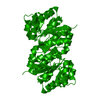


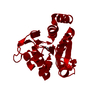
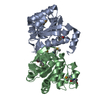
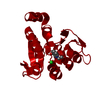
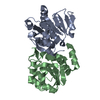

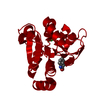
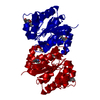
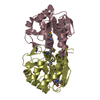
 PDBj
PDBj
